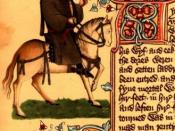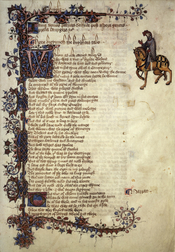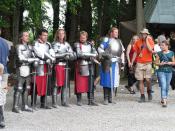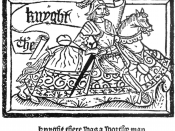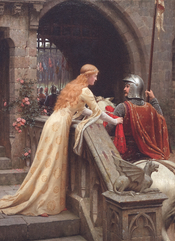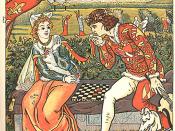In what ways and to what extent is Chaucer's Knight's Tale appropriate to its teller, "a verray parfit, gentil knycht?Sophie KingChaucer's Knight's Tale is a story in which the courtly ideals of the chivalric knight are questioned. The narrator of the story, a knight himself, tells us about the noble Theseus and his rule over Athens. Theseus is appropriate to the description "a verray parfit gentil knycht" as much as the narrator himself but we come to question the perfection of both as the story progresses.
Although based on classical Greek mythology Chaucer writes in medieval terms. There is still great debate today about the values of the medieval knight that so often appears in Chaucer's work. Reading courtly poetry and stories of medieval romance might trick us into believing the nobility of knights but the reality would have been much less romantic in the cruel and turbulent times of the medieval world Chaucer writes about.
The Knight's tale might be said to uphold the power of chivalry and express the nature of the noble life, but as the story unwinds it becomes easier to see the limitations and realities of chivalric power and raises profound questions on courtly love.
Winthrop Wetherbee suggests,The relationship of love and war is one sided: honouring his lady confirms the knight's courtesy but it is most of all an excuse for the self-centered enterprise of demonstrating prowess. In practise warfare remains the true test of chivalry and courtesy is largely the stuff of courtly poetryThus there is a clash of priorities and it appears impossible for the perfect knight to be loyal to his neighbour, to his lady, to God, to war and to everything else the code of chivalry entails. The nature of warfare in itself is a crime against courtesy. An example of this is within the fight between Arcite and Palamon in the forest. They courteously help each other to arm and then a fight to the death ensues. It raises the question whether it is even possible to be a perfect and noble knight when the two main aspects of the tale are love and war. Being a knight becomes a contradiction in itself.
Although Chaucer uses "a verray parfit gentil knycht" in the general prologue to describe the narrator, it seems to refer directly and undoubtedly to the character of Theseus too. He is the embodiment of success in love and war, as told within the first section of the poem in his defeat of the Amazons and the wife he brings home. Critics have said Theseus is the spokesman of mood and morals throughout the story. He is equal in nobility of character and depth of feeling. He embodies chivalric heroism in its highest form.
Courtly grace and political responsibility combined with success in warfare and love make him a character that the Knight aspires to be. He never doubts the values and decisions of Theseus making it easy as a reader to see the Duke as a "verray parfit gentil knycht. But we must of course always be cautious of the narrator. Theseus is symbolic of the ideal knight which is exactly what the teller intended him to be when telling the story within the Canterbury tales. I call him symbolic as we never really learn much of his personality. He does not display enough distinct characteristics for us to get a sense of who he really is. We only know of his courageousness and wisdom throughout. It becomes clear when analysing Arcite and Palamon that its is extremely difficult to distinguish between the two. Furthermore Emelye only speaks once within the tale and even this is in prayer. This suggests the meaning of the Knight's Tale is not displayed through characterization. A. C. Spearing says it is, "more like a perception of the nature of the human condition as a whole."Returning to Theseus, we witness his first example of gallantry behaviour. After winning at war he discovers the weeping widows and their husbands, "dead bodyes vileynye" since Creon refuses to allow proper burials. Since vileynye is the opposite of gentilnesse Theseues's gentile qualities are emphasised when he vows to affront this offence against courtliness. He displays a sense of compassion as they appeal to his pitee;Som drope of pitee thurgh thy gentillesse,Upon us wrecched women lat thou falleThis is the first of many examples of Theseus's chivalric behaviour but he is not the only knight in the tale to display chivalric qualities. There are moments of noble behaviour between Arcite and Palamon, for example in the forest scene when both are seized by a violent jealousy and are on the point of fighting to the death. Chivalry remains at the forefront of their minds as they both gallantly and courteously help each other to arm before the battle ensues. It seems ironic and rather absurd to a modern audience that following this chivalric behaviour they switch so easily from brothers to warriors. The battle "reduces them to wild beasts." When reading the following lines it is difficult to see the courteousness and selflessness that a knight is supposed to portray;In his fightyng were a wood leon,And as a crueel tigre was Arcite;As wilde bores gonne they to smyte,That frothen whit as foom for ire wood.
Up to the ancle foghte they in hir blood.
Yet we must see the conflict in chivalric terms. Rather than a means of affirming the gallantry of these two knights I would argue it works to emphasise Theseus's chivalric qualities. On finding them in this state he acknowledges loves' violent effects and takes pitee on the two knights. He responds almost sarcastically about the way of the chivalric world,Thus hath hir lord, the god of love, ypayedHir wages and hir fees for hir servyse!Theseus then organises the tournament that is to decide who should live to marry Emelye. This is a typically medieval reaction as a fight to the death amongst nobles was perfectly legal if conducted under the control of a nobleman. Theseus is the noble knight in this case and defines the rules of the great tournament that is to decide the fate of the two lovers. Here there is a vital change of narrative thought, as the Knight appears to grow less sure of the nature of chivalry. The tournament creates death and destruction despite valiant attempts to prevent bloodshed with the ban of certain weapons of war. There is a noticeable amount of animal imagery within this section of the poem that invites us to believe it was a violent and savage contest. Theseus does not quite achieve what he perhaps hoped to. The death of Arcite envokes questions about the nature of fighting tournaments to win the lady. Critics have suggested A Knight's Tale demonstrated Chaucer's distaste of this chivalric practise, viewing it as an outmoded procedure.
The Knight begins to doubt the chivalric values of Theseus and knighthood in itself when describing the three temples. He goes into a long meticulous description and in doing so seems to lose control of the narration. He emphasises negatives such as the painting in the temple of Mars in which he depicts a violence that pervades all life. By describing the terrifying power of the Gods, the Knight reveals an awareness of the dangers of the world and lack of power mere mortals have. After promoting the noble nature of Theseus's authority as a knight he comes to realise that even a "verray parfit gentil knycht" cannot make much difference in such a cruel world. This is reiterated in Theseus's speech at Arcite's funeral when he describes life as a foule prisoun. Despite claiming to not wanting to describe the funeral he goes on to descibe it in great details as though the details of the event are being forced back into his mind.
The description of the perfect knight is appropriate to teller and protagonist and proves to make a vital point within the story. Critics have said it perhaps answers the question of what the true knight is worth a little too easily and so we perceive the ideals of the knight in a negative way.
I would conclude by saying that the description of a "verray parfit gentil knycht"could easily be said to be appropriate to both Theseus and the narrator and what they aspire to be, but the truth is that perhaps this idealism is unreachable and the tale in fact makes us question the "perfection" of the medieval knight. His final speech in which he realises that by dying young and nobly Arcite has escaped the "foule prisoun" of life, Thesues proves the lack of power he has to create order despite his authority and nobility. Wetherebee says, "The conqueror whose chivalry had once seemed all sufficient has been humbled." And so the disorderliness of life is asserted and despite all aspects of chivalric intentions, as humans we are merely puppets to a greater power. The Knight has tried to promote his fellow noblemen within his tale and,"he never abandons chivalric decorum, but we sense that he has again come close to acknowledging the fundamental limitations of the code by which he lives. " We learn from this that chivalry is by no means faultless and despite trying to promote his perfect knight, the teller has actually come to realise the imperfections that chivalry entails.
Although the Knight's Tale was meant to assert the ordering power of chivalry it becomes clear that it is no real means of controlling life. It's rituals and courtly codes of conduct are made insignificant in view of death caused by war and the overruling power of the Gods. The tale makes us doubt the entire idea of chivalry and makes us question whether it is even possible to call any of the knights involved in this essay, narrator or characters "verray parfit" or "gentil." The Chaucer's Knights Tale is therefore appropriate to its teller not because both are perfect in their knightliness but because as the tale unravels and the truth about chivalry comes to the forefront, so too does the teller's narrative prowess. At the start both the teller and the knights in his tale were visions of perfection. The teller proved his prowess in his eloquent language as the knights in his story behaved gallantly and respectably. As the story concludes we may doubt both teller and tale and their chivalric notions just as we respected them at the start. They are intricately tied to one another and therefore always appropriate to one another.
BibliographyBishop, Ian. The narrative art of The Canterbury tales : a critical study of the major poems. London : Dent, 1988Spearing, A.C. The Knight's Tale. London : Cambridge University Press, 1966.
Wetherbee, Winthrop. Geoffery Chaucer, The Canterbury Tales. Cambridge : Cambridge University Press, 1989.
